Margaret Ransom, an award-winning writer who has worked in the horse racing industry for decades, recently moved to Texas from California and started The Bridge Sanctuary. Its mission is to bridge the gap from forgotten horses to forever safe horses. Here’s her latest rescue story.
By Margaret Ransom
Hello, Blanche.
I’d like to introduce you to Purgatory Cat. She is an 18-year-old daughter of Tale of the Cat and the Damascus mare Damearco.
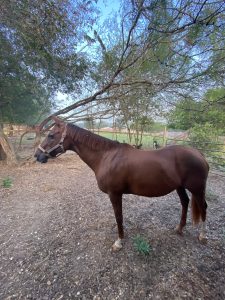 But here at The Bridge she is Blanche.
But here at The Bridge she is Blanche.
We pulled Blanche from a last-chance-before-shipping auction in September because, well, she didn’t deserve to be dumped there.
Blanche was bred in Kentucky by Bona Terra Farm and before she began her career, passed through the auction ring three times – she first RNAd for $95,000 as a weanling at Keeneland in 2003, sold for $90,000 as a Fasig-Tipton yearling the following July and sold again for $180,000 as a Fasig-Tipton Midlantic 2-year-old in 2005. She raced twice for the partnership of Brian Rose and Collin Purcell in the care of Patrick Biancone and earned $315 before injury sent her to the breeding shed, where she more than did her share for the industry.
Oh, and she is in foal again. To a well-bred son of Tapit named Moro Tap, who stands here in Texas.
Blanche has had eight foals, including a Royal Academy, a Hat Trick and a Chapel Royal. None were successful on the track, unfortunately. And I was told by her former caregiver that she has had some issues with foaling, which makes sense looking at her produce record. These are reasons why she ended up in such a precarious position. Basically, because of her failure to produce she was discarded. Like trash. And instead of doing the right thing for her, someone decided to squeeze every drop and sell her for a price just over what she’d bring as a horse bound for slaughter. She deserved better, she earned better.
A fish out of water
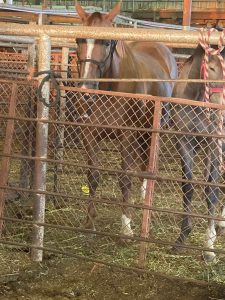 When I found her in the pen on the night of the auction, she was quiet and appeared dazed. She stood awkwardly with a way-too-big rope halter tied to the fence. Not that there’s anything wrong with a rope halter, but they are a far cry from the leather ones that, as a well-bred Kentucky girl, she’d been used to for most of her life.
When I found her in the pen on the night of the auction, she was quiet and appeared dazed. She stood awkwardly with a way-too-big rope halter tied to the fence. Not that there’s anything wrong with a rope halter, but they are a far cry from the leather ones that, as a well-bred Kentucky girl, she’d been used to for most of her life.
She looked around at the chaos, almost afraid to move. I tried to inspect her in stealth mode so as not to tip anyone who might jack up her price to my presence, but it was hard to contain my emotions as I studied her, very much a fish out of water among the seasoned ranch horses, ponies and unhandled livestock. I was marked immediately, and I knew I’d be paying more.
When the bidding started, I moved to the front of the ring and kept my eyes on the auctioneer. I let the bidding go and when it stalled, I raised my number. After a bit of back and forth, I was announced as the winning bidder at $2,000, which I felt was reasonable for this lovely girl who clearly needed a soft place to fall. But chiefly, the price saved her from ending up in the wrong hands, or on a Facebook page with her price doubled for ransom, her very life used as emotional blackmail against kind-hearted OTTB lovers. Or worse, headed to Mexico and a slaughterhouse.
How Blanche arrived in such a spot
The story of how she ended up in the auction is convoluted and I’m not terribly sure how she got there. Her last longtime owner, who owns a thoroughbred farm outside Dallas, apparently purchased Blanche privately a few years ago and got a couple of foals out of her, and then last December sent her to the Texas Thoroughbred Association sale not in foal where she RNAd for $2,000.
He then bred her this year and apparently sold her in foal in a no-reserve online auction at the end of August. And then I found her online at a Texas livestock auction set to sell the first of September where well-bred thoroughbred broodmares are less than rare.
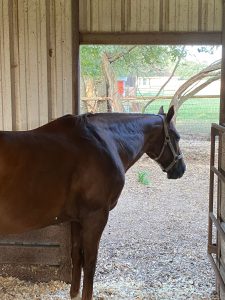 What’s the saying? One man’s trash is another man’s treasure?
What’s the saying? One man’s trash is another man’s treasure?
Blanche is a treasure, for sure. She is kind, smart and classy and sometimes a little sassy. And like Blanche Devereaux, she is a Golden Girl in every sense of the expression. She settled in like a champ, too. After she finished in quarantine, she bonded quickly with the other dumped broodmare, Vivian (Go For Glamour) and the gelding George (Clever Cody) and is happy and comfortable with a sunny disposition and quiet, calm demeanor. The worst thing about her is that her feet are in terrible shape, and I am working with the farrier to fix some of the serious issues, which are costly. But I am relieved to say she’s otherwise healthy.
Finding a forever home
Two things we know for sure: this will be her last foal and she will be safe forever. The Bridge will find her a forever home after the baby comes, hopefully together with Vivian, but she won’t ever be dumped for not being someone’s useful commodity again. Once the baby arrives arrangements will be made for his (or her!) secure future, too. The Bridge may even have a baby naming contest, we shall see when the time comes.
But again, The Bridge is now on its second dumped broodmare who should have been given a safe and secure forever after giving her entire life to better the thoroughbred racing and breeding industry. I thoroughly applaud industry initiatives like the Retired Racehorse Project, where former racehorses show their skills in second careers over a three-day period in Kentucky, but what about the ones whose only career has been having babies? Why are they not celebrated, too? Why is dumping them ever OK? And how do we implement safeguards for their secure futures?
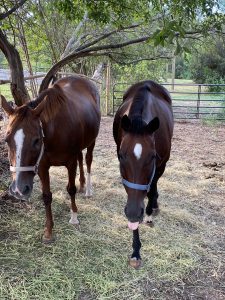 Funding, funding, and more funding always a big help
Funding, funding, and more funding always a big help
For rescuing My friend, OTTB advocate Lynn Parks, was so helpful gathering info about Blanche and was able to raise some of the funds for her purchase price, but I covered the rest with a little bit of help from USRacing. I am planning for her to have her foal at a friends as the sanctuary is not currently set up for foaling, but we need to start planning for that, so if you want to help The Bridge help Blanche (and baby!) please consider donating. Your help allows the rescue to help more horses in need. The Bridge is and has been entirely self-funded until it goes through the accreditation process, so there isn’t any industry support yet. I don’t beg often, but I am begging now. Even the smallest donations make a significant difference.
Thank you in advance — on behalf of Blanche — but especially from me and the rest of us here at The Bridge. Your support means everything.
—
The Bridge Sanctuary is a registered Texas corporation and 501(c)(3) non-profit rescue; all donations are tax deductible. You can donate via Venmo. PayPal, Cash App or on our website at thebridgesanctuary.com
Venmo: @TheBridge-Sanctuary
Cash App: $redransom
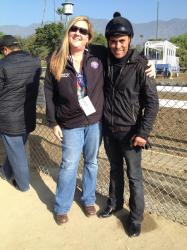
California native and lifelong horsewoman Margaret Ransom is a graduate of the University of Arizona’s Race Track Industry Program. She got her start in racing working in the publicity departments at Calder Race Course and Hialeah Park, as well as in the racing office at Gulfstream Park in South Florida. She then spent six years in Lexington, KY, at BRISnet.com, where she helped create and develop the company’s popular newsletters: Handicapper’s Edge and Bloodstock Journal.After returning to California, she served six years as the Southern California news correspondent for BloodHorse, assisted in the publicity department at Santa Anita Park and was a contributor to many other racing publications, including HorsePlayer Magazine and Trainer Magazine. She then spent seven years at HRTV and HRTV.com in various roles as researcher, programming assistant, producer and social media and marketing manager.
She has also walked hots and groomed runners, worked the elite sales in Kentucky for top-class consignors and volunteers for several racehorse retirement organizations, including CARMA.In 2016, Margaret was the recipient of the prestigious Stanley Bergstein Writing Award, sponsored by Team Valor, and was an Eclipse Award honorable mention for her story, “The Shocking Untold Story of Maria Borell,” which appeared on USRacing.com. The article and subsequent stories helped save 43 abandoned and neglected Thoroughbreds in Kentucky and also helped create a new animal welfare law in Kentucky known as the “Borell Law.”Margaret’s very first Breeders’ Cup was at Hollywood Park in 1984 and she has attended more than half of the Breeders’ Cups since. She counts Holy Bull and Arrogate as her favorite horses of all time.She lives in Robinson, Texas, with her longtime beau, Tony. She is the executive director of the 501(c)(3) non-profit horse rescue, The Bridge Sanctuary.


